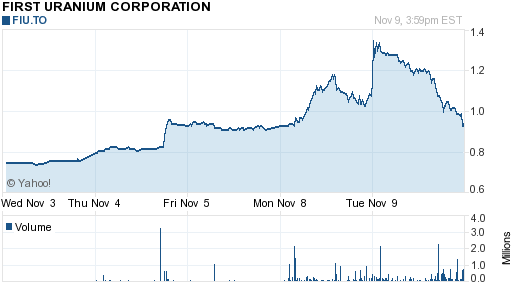I don’t know why I find the trading of First Uranium (TSX: FIU) to be this exciting, but it is fairly obvious the market is pricing in a turnaround in its operations. Considering that it couldn’t have been managed worse in the year 2009, this is not entirely surprising. FIU shares are up about 60% over the past month. A share price of $1.25 gives it a capitalization of $220 million. The shares will start to face resistance as it cuts into the overhang caused by the secured note issue (which is a $150M issue with a $1.30/share conversion price). Conversion of the notes will result in about 115M shares issued, or about 40% of the company.
Valuing the notes, subordinated debentures and equity is not a trivial process.
The notes currently are not the most liquid product on the planet, with a closing bid/ask of 105/124 cents on the dollar. These notes are also secured by assets and in the event of a default would likely have some sort of recovery. Using the flawed Black-Scholes model, and using a 50% implied volatility (which is an incorrect estimate) gives a 36.5 cent per share value per call option at $1.30, expiring in March 2013. At 105, ignoring the conversion feature of the note, represents a 6.7% current yield and a -2.0% capital loss for the remainder of the 2.4 year term. The actual return realized by noteholders will depend on FIU’s trading price.
Using the 50% implied volatility figure, the option embedded within the notes have a “delta” of about 65%, which means that for every 1% that the equity changes, the underlying value in the conversion feature will change 0.65%. If FIU trades significantly above $1.30/share, the equity portion will dominate the value of the note, while if FIU trades under $1.30, other considerations such as ability to liquidate the assets become more of a consideration. There is no “clean” way of valuing these notes, as you have to separately calculate the fixed income and equity components, despite the fact that both of them are linked!
The unsecured debentures, maturing on June 30, 2012 are trading bid/ask 75/77, and using the midpoint as a reference, the yield to maturity is a whopping 23.0%; or the current yield is 5.6% and capital gain on maturity at par is 18.7%, for a joint yield of about 24.3%. It is likely that if FIU is trading significantly above $1.30 around the maturity date of the debentures that they will be able to refinance them. If FIU is trading under this, then it becomes increasingly likely that the debentures will receiving significantly less – the people holding the debentures can force a bankruptcy, but given their low seniority they will likely not be in much of a position to doing so.
The equity has traded historically as high as $8/share in May of 2009, and the company was very smart to pull off an equity offering near this price (before the shares tanked). Indeed, if this valuation was at all correct, even when you factor in the subsequent dilution, there is the potential to see the operation go for $3-$4/share if everything goes to “plan”. Of course, it has not in the past, and will likely have issues in the future!
FIU’s capital structure is a very strange one to analyze, especially with respect to the profitability of its operations. As I stated before, this is a classic high risk, high reward situation. In no way would anybody be sane to “bet the farm” on it, but a small allocation is in order – which is what I have at present in both the notes and debentures but not the equity. The notes already have enough equity value in them that can take direct advantage of a price rise in equity.

